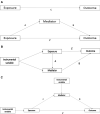Mendelian randomisation for mediation analysis: current methods and challenges for implementation
- PMID: 33961203
- PMCID: PMC8159796
- DOI: 10.1007/s10654-021-00757-1
Mendelian randomisation for mediation analysis: current methods and challenges for implementation
Abstract
Mediation analysis seeks to explain the pathway(s) through which an exposure affects an outcome. Traditional, non-instrumental variable methods for mediation analysis experience a number of methodological difficulties, including bias due to confounding between an exposure, mediator and outcome and measurement error. Mendelian randomisation (MR) can be used to improve causal inference for mediation analysis. We describe two approaches that can be used for estimating mediation analysis with MR: multivariable MR (MVMR) and two-step MR. We outline the approaches and provide code to demonstrate how they can be used in mediation analysis. We review issues that can affect analyses, including confounding, measurement error, weak instrument bias, interactions between exposures and mediators and analysis of multiple mediators. Description of the methods is supplemented by simulated and real data examples. Although MR relies on large sample sizes and strong assumptions, such as having strong instruments and no horizontally pleiotropic pathways, our simulations demonstrate that these methods are unaffected by confounders of the exposure or mediator and the outcome and non-differential measurement error of the exposure or mediator. Both MVMR and two-step MR can be implemented in both individual-level MR and summary data MR. MR mediation methods require different assumptions to be made, compared with non-instrumental variable mediation methods. Where these assumptions are more plausible, MR can be used to improve causal inference in mediation analysis.
Keywords: Mediation analysis; Mendelian randomisation; Multivariable Mendelian randomisation; Two-step Mendelian randomisation.
Conflict of interest statement
The author declare that they have no conflict of interest.
Figures




References
-
- Wright S. The method of path coefficients. Ann Math Stat. 1934;5:161–215. doi: 10.1214/aoms/1177732676. - DOI
MeSH terms
Grants and funding
LinkOut - more resources
Full Text Sources
Other Literature Sources
Medical

